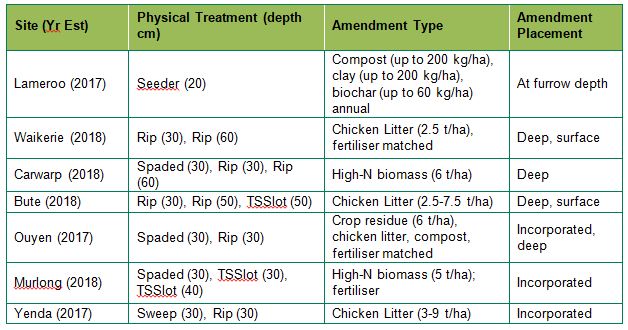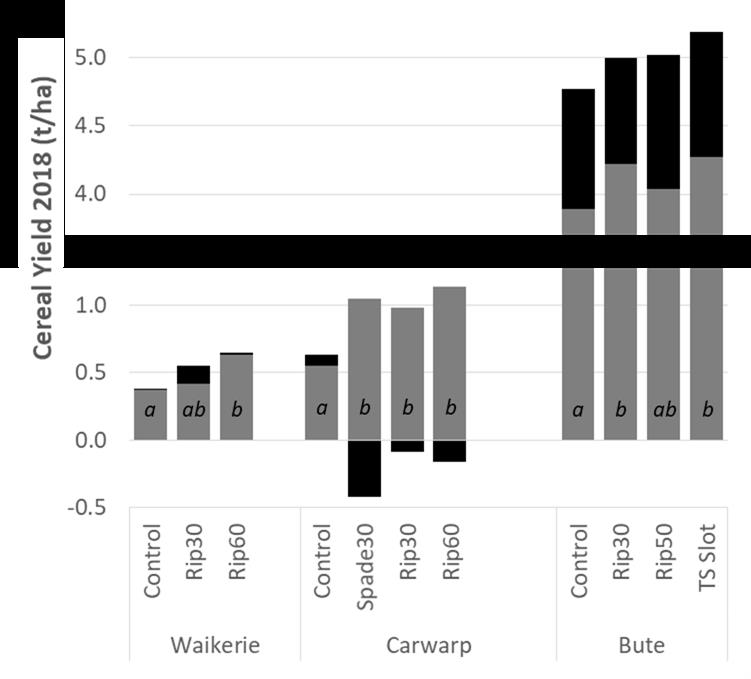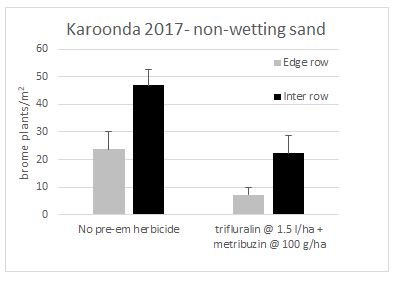Getting the edge on improving crop productivity on Southern sandy soils
Getting the edge on improving crop productivity on Southern sandy soils
Author: Therese McBeath, Lynne Macdonald, Rick Llewellyn, Vadakattu Gupta (CSIRO Agriculture and Food); Jack Desbiolles (University of South Australia); Michael Moodie (Frontier Farming Systems); Sam Trengove, Stuart Sheriff (Trengove Consulting) | Date: 26 Feb 2019
Key messages
- Using a seeder edge-row sowing has increased crop establishment and competition with weeds, with potential grain yield benefit while some soil wetter chemistries and 20cm deep-till sowing have increased grain yield.
- In compacted soils, ripping and spading have had significant yield effects, even in a very low rainfall season.
- Organic inputs or fertiliser supplied with ripping and spading have shown varied responses.
Aims
The aim of this work is to increase crop water use on sandy soils in the Southern cropping region by improving constraint diagnosis and management of under performing sands. To achieve the best possible profit-risk outcomes we are testing strategies that are relatively low cost and implemented with a seeder, through to very expensive and high soil disturbance interventions that require specialised machinery.
Water-use and productivity on sandy soils are commonly limited by a range of co-occurring soil constraints that limit root growth. Constraints include a non-wetting topsoil-layer with poor crop establishment, soil pH issues (both acidity and alkalinity), poor nutrient supply, sub-layer compaction and the presence of other subsoil constraints. Opportunities to overcome these constraints to improve crop water-use include low cost seeder based strategies (e.g. guided row sowing, seed placement, wetting agents, fertiliser placement, furrow management) and higher investment profile amelioration approaches (deep ripping, spading, deep ploughing).
Method
From 2014 to 2017 we experimented with edge-row sowing (sowing as close as practical to the previous crop row, without affecting the stubble row integrity) on a non-wetting sand at Karoonda (SA Mallee), with evaluation of the effects of the strategy on surface and sub-surface soil water, crop establishment, weed competition, root disease, nitrogen supply and crop yield. Findings from these experiments informed the approach taken in the GRDC Sandy Soils Program (CSP00203) that commenced in 2017. The Sandy Soils Program investigates both seeder based and more intensive (ripping/spading) methods at seven newly established sites. The dominant soil constraints targeted were physical and nutritional constraints alone (Waikerie and Bute in SA, Carwarp, and Ouyen in Vic), or in combination with water-repellence (Murlong and Lameroo in SA) or acidity (Yenda, NSW). A summary of the treatments at each site are provided in Table 1.
We expanded the concept of edge-row sowing by repeating this treatment over permanent row zones, developing over-time as ‘fertility strips’ on a water repellent sand at Lameroo. A permanent fertility strip involves sowing crops in very close proximity to previous crop rows using a side-banding knife point system, whereby the row is sown to one side of the stubble row in the second year and to the other side in the third year. The cycle is repeated in Year 4 reinforcing a permanent strip where annual inputs are cumulated. Additional to mineral nutrition inputs to the furrow, a number of contrasting amendments (compost, clay or biochar) are also applied every year for three years (to reduce upfront risk), one of which includes placement at 20 cm depth, in contrast to the baseline 10 cm furrow depth. All these fertility strip treatments are compatible with a zonal application in paddock managed via soil zone map. A dedicated trial is also investigating the impact of imposing edge-row sowing across variable soil types in the swale-dune systems dominant in the SA-Vic sandy soil region. At the severely water repellent site near Murlong (Eyre Peninsula), the impact of 13 different wetting agents (both surfactants and humectants) in single and dual placement configurations were tested, with product costs between $12 and $41 per ha.
A range of more intensive interventions have been tested at Ouyen, Murlong, Waikerie, Carwarp, Yenda and Bute to evaluate whether increasing the depth of physical treatments (ripping or spading) and/or amendments (lime, fertiliser, chicken litter, crop residue or compost) within the profile results in cost effective outcomes (Table 1).
Table 1. Summary of Sandy Soil project treatments indicating the type of physical amelioration approach, amendments used, and placement strategy.

* amendments used at the trial sites vary depending on regional availability, where chicken litter is considered unavailable in the VIC Mallee and Eyre Peninsula. TSSlot- topsoil slotting/ inclusion plates.
Results
Root disease is often seen as the greatest drawback of edge row sowing. Inoculum levels for Rhizoctonia, Take All and Crown Rot are generally higher in soils on the edge-row compared to inter-row which reflected in disease incidence. However, in spite of the high levels of pre-sowing inoculum in 2017, disease incidence was often low with edge-row sowing (Table 2). In the 2015 and 2016 growing seasons, the disease incidence was in fact lower for edge-row sowing despite higher inoculum load, which may be attributed to the overall increase in disease suppression potential of soil from long term stubble retention and conservation management practices
Table 2. Soil borne disease risk ratings for Take-all (Ggt), Rhizoctonia (RsAG8) and Fusarium crown rot in the soil edge-row and in the inter-row at the time of sowing at Karoonda in 2017 and a combined disease incidence rating (GS31, 2017 growing season).
Edge-row sowing often improves crop establishment, especially on non-wetting sands. For example, in 2017 establishment was improved by nearly 40% with edge-row sowing at Karoonda, resulting in greater early biomass at first node (crop growth stage 31). However, as in previous seasons, the benefit of early establishment and greater crop biomass with edge-row sowing were not transformed into significant benefits for grain yield in this highly variable water repellent soil environment.
One of the greatest advantages of edge-row sowing has been increased crop competition and subsequent suppression of weed seed set of brome grass. For example, in 2017 there were 10 brome plants/ m2 morewhere wheat was sown inter-row vs. edge-row and no pre-emergent herbicides were used (Figure 1). Where trifluralin and metribuzin were used in conjunction with edge-row sowing, the brome grass population was reduced by a further 20 plants/m2. In 2016, this weed suppression led to a 72% reduction in brome grass seed set in edge-row treatments.
Figure 1. Brome grass population (plants/m2) in a wheat crop sown edge-row or inter-row and with or without pre-emergent herbicide on a non-wetting sandy soil at Karoonda in 2017. Pre-emergent herbicide treatment was a mix of trifluralin at 1.5 L/ha and metribuzin at 100 g/ha was incorporated by sowing.
Edge row seeding is an effective mechanism for managing the brome grass weed seed bank. The edge row seeding position not only enhances the competitive ability of the crop through improved establishment and early vigour, but also promotes weed germination in the part of the paddock where the crops competitive ability is greatest. For example, in 2016, the density of brome that emerged in previous year’s crop row was at least 7 times higher than the density of brome in the inter-row reflecting the better germination conditions in the previous year’s row.
Expanding the concept of edge row seeding to the permanent fertility strip in 2017 revealed a 0.6 t/ha response when the amendments were placed at 20 cm depth with the seeder compared with 10 cm, while the variety of input treatments did not show a significant effect. In 2018, a poor season (decile 1) at Lameroo with crop establishment challenges there was 1.35 t/ha barley grain yield for inter-row sowing, 1.85 t/ha from sowing on the edge-row (3-4 cm offset) with a further 0.35 t/ha (2.2 t/ha yield) for sowing on the edge-row with amendments applied at 20 cm depth. A separate test revealed that it was the physical disruption rather than the addition of amendments that generated this significant deep-till effect (this option is compatible with tine seeders having a press-wheel regulated seed banding boot, where furrow depth can be independently adjusted on the go).
The value of soil wetter technology was demonstrated at the Murlong severely repellent site (MED 2.8-3.2 in the 0-10 cm layer) with up to 122 % greater plant establishment at 38 DAS and up to 21.3 % (0.22 t/ha) wheat grain yield increase over the control (1.02 t/ha). The data showed grain yield correlated positively (r=+0.76) with plant density. Year 1 results suggest some superior product chemistries and some ability to synergise in dual product application. Their evaluation will continue in the 2019 growing season.
A wide range of experiments have demonstrated that large physical interventions (ripping, spading, deep cultivation) can improve crop productivity in compacted sandy soils. The ability to further increase yield gains with effective cost benefits by incorporating amendments (fertilisers, manure, crop biomass) is not as well understood. Depth of placement and type of amendment influence the rooting depth, the timing of nutrient supply, and access to profile moisture. These factors influence the balance of crop growth, development, and grain filling.
Targeting the depth of amelioration to compaction thresholds (with/without deep placement of amendments) three new experiments (2018) demonstrated a range of site specific responses (Figure 2). The potential for yield gains at Waikerie was limited by available water (95 mm growing season rainfall, GS, low stored moisture), with small yield gains observed in 60 cm ripping treatments (+0.3 t/ha), and no response to deep placed nutrition. At Carwarp (~70 mm GS rainfall, good stored moisture) the yield response to a range of amelioration approaches (ripping, spading) were relatively consistent (+0.5 t/ha) with no significant response to depth, despite evidence of deeper crop water-use. Increasing profile nutrition through incorporation of N-rich biomass had either no benefit (deep placed) or a negative yield effect (spading) associated with high early biomass production. In contrast to the dominance of physical effects at Waikerie and Carwarp, crop yields at Bute were more responsive to improved nutrition (application of 7.5 t/ha surface chicken litter) demonstrating yield gains of approximately 0.9 t/ha compared to an average gain of 0.3 t/ha from physical interventions alone. The Bute site had the lowest level of soil compaction across the project sites. All trials continue for a further 2 years to evaluate the longevity of physical and nutrient carry-over effects.

Figure 2. Cereal yields across three amelioration trial sites including non-ameliorated control, ripped (Rip30, Rip50, Rip60), spaded (Spade30), or topsoil slotted (TSSlot30) treatments, and where number indicates depth (cm) of intervention. Grey bars represent yields under best practice fertiliser inputs, while black bars indicate gains/losses under nutrient enriched treatments. Letters indicate significant amelioration impacts within sites (n=4), noting broken y-axis to account for higher yields.
Conclusion
There are a range of strategies that are being evaluated to manage non-wetting, compaction and poor fertility in sands of the Southern cropping region. These strategies have varied in cost, reliability and longevity of effect, all key factors influencing profit and risk.
Acknowledgments
The research undertaken as part of this project is made possible by the significant contributions of growers through both trial cooperation and the support of the GRDC, the author would like to thank them for their continued support. CSP00203 gratefully acknowledges industry collaboration and support including Groocock Soil Improvement Pty Ltd, Peats Soil & Garden Supplies, Neutrog Australia Pty Ltd,Incitec Pivot Ltd, Wengfu fertilisers, and soil wetter suppliers (SACOA, SST Australia Pty Ltd, Wilchem Australia, ICL Specialty Fertilizers, Victorian Chemical Company Pty Ltd, BASF, Chemsol Australia, BioCentral Laboratories Ltd) . The broader Sandy Soils Project team is gratefully acknowledged for valuable input.


